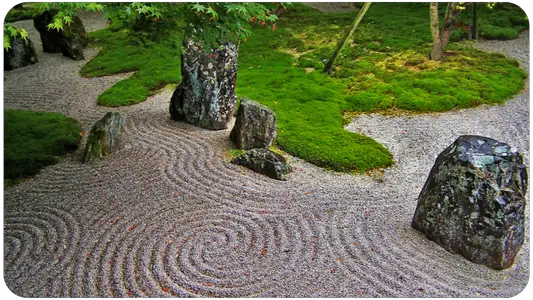Anitya (Punjabi: अनिच्चा; Latin transliteration, anicca; simplified Chinese: 无常; traditional Chinese: 無常; pinyin: wúcháng; Korean: 무상 (無常, musang); 無常 (mojō? ); Tibetan: མི་རྟག་པ་, Wylie: mi rtag pa, THL: mitakpa), "non-eternity" or more generally impermanence, is according to Buddhism one of the three characteristics or trilakshana of everything.
According to Gautama Buddha, attachment to impermanent things proves to be the cause of suffering, dukkha, because what is impermanent cannot be satisfying.
Impermanence is also the promise of change: progress on the spiritual path is only possible because like everything else, our present unawakened state is impermanent.
Impermanence according to different schools
Impermanence in Theravada
The impermanence of things is the appearance, passage and transformation of things or the disappearance of things that have begun to be or have appeared. This means that these things never persist in the same way, but disappear and dissolve from one moment to the next (visuddhimagga)
Impermanence is universal and concerns all conditioned states, even the highest and most subtle:
Nowhere do I see a permanent, stable, unchanging situation, such that one can remain eternally in the same condition. (Alagaddûpama-sutta)
Associated with impermanence is its contemplation, which is one of the eighteen main practices of vipassana. The traditional description of the stages of vipassana relates the stage of bhanga nupassana, the contemplation of dissolution, in which the meditator realizes that phenomena only disappear continuously.
Impermanence in the Mahâyâna
Like any school claiming to be Buddhist, the Mahayana is based on the Dharma Seals. Depending on the school, there may be three seals, but generally there are four:
All compounds are impermanent,
All compounds are unsatisfactory,
Everything is empty of its own existence,
Nirvana is peace.
Now if we believe the first of the four Seals of Buddhism, all compounds are impermanent. The Mahayana and its schools of thought like the Madhyamika distinguish two meanings of compound:
composed of constituent parts,
composed of causes and conditions.
It is the second meaning that is referred to here (See His Holiness the Dalai Lama's teaching on the 400 Stanzas of Aryadeva in Hamburg, July 2007, where he explains the two meanings of "incomposite space").
So, as we see in Chandrakirti's Madhyamakavatara, the Madhyamika envisages permanent phenomena which are therefore not composed of causes and conditions. Therefore only phenomena that are produced, or composed (causally) are impermanent.
This is different from the 3rd Seal according to which everything is empty of its own essence, not only the products, but also the permanent phenomena, even the non-existent ones which do not have a referent but depend nevertheless on a consciousness which conceives them.
To be impermanent is to cease through a natural and continuous alteration. However, some phenomena have no beginning and can have an end, like samsara (in this case we will not say that samsara is a produced or unproduced phenomenon but that it is simply a temporary aberration of the natural state).
Other phenomena may have a beginning but not an end, like the nirvana realized by an accomplished person, or the qualities of a Buddha.) Something may also have no beginning and no end: like the natural nirvana of all that is, emptiness in general;) and something may have a beginning and an end, like phenomena that are produced and therefore subject to impermanence.
In the Mahayana, there are two main forms of impermanence:
gross impermanence (Tib.: mitakpa rakpa)
subtle impermanence (mitakpa thrawa).
Coarse impermanence is one of the obvious phenomena (ngeungyur) which appear to us directly, in a sensory way. For example, we see a glass break, we perceive the end of a sound, the movement of clouds, etc.
Subtle impermanence is part of the semi-hidden phenomena, which do not appear to our direct perception but which we have the possibility to apprehend through logical inference, or deduction.
For example, as we see a flower wither, or our body age, we see that this alteration did not happen all at once. And so we know that the process of alteration, of impermanence, is continuous and insensitive.
We then come to study this phenomenon and we understand that, in our relative reality, such an effect is born of a cause but cannot be born of a permanent cause. Indeed, if the seed remained a seed forever, the shoot would never have the opportunity to appear.
So the seed must cease for the effect to occur. And since the cause is impermanent, its effect is also impermanent.
It then becomes in its turn the evanescent cause of a new effect, etc.
We do not perceive this subtle impermanence directly, for every phenomenon produced is a continuum whose instances, though different, are similar (tib. dèndra shenjoung): so that this continuity does not appear to us at once as in uninterrupted alteration.
We only notice it when the perceived object ends up being quite different from the one we had seen before. Like a wrinkle or a wilting flower.
Recognizing impermanence and realizing its hold on all products and thus on ourselves and our precious human existence allows us to develop renunciation and perseverance in the cultivation of altruism: the willingness to work constructively today in order to achieve eternal bliss and that of all beings.
See the Tibetan Düra (Compendium of Debates) on impermanence, which is based on the Abhidharma and its Indian commentaries.
Impermanence in Tibetan Buddhism
In the common preliminary practices of Mahamudra, death and impermanence are the subject of the second meditation.
"Secondly, this world and everything in it is transient
Especially the life of beings is as fragile as a bubble
The moment of our death is unpredictable, and when it comes, we are only a corpse
Since it is the dharma that is beneficial to us, let us practice it with ardor.
The meditation on impermanence is found in the Lam Rim (stages of the Way) of the four Tibetan orders outside the Bönpo school (although it is probably also mentioned in the Shang Shoung Nyen Gyü beunpo). These Lam Rims synthesize in a coherent way all the teachings of the Buddha, Suttas palis, Sanskrit Sutras and Tantras.
For example for the Nyingmapa school:
The Path of Great Perfection, Dza Patrul Rinpoche (ed. Padmakara).
or also Treasury of Precious Qualities, Jigme Lingpa (ed. Padmakara).
for the Kagyupa school:
The Precious Ornament of Liberation, Gampopa Sonam Rinchen (ed. Padmakara).
Et si vous m'expliquiez le bouddhisme, Ringou Tulkou Rimpotché (ed. Nil).
The Way of the Buddha, Kalu Rinpoche (ed. Seuil).
The Dharma, Kalou Rinpoche (ed. Kunchab).
for the Sakyapa school:
Triple vision-
Triple line, Ngor Tchen Könchog Lhundrup (ed. Tibetan Buddhist Center).
The Three Levels of Spiritual Perception, Deshung Rinpoche (ed. Wisdom).
and for the Gelugpa school:
The Great Book of Progression to Enlightenment (T. I and II), Je Tsongkhapa (ed. Dharma).
The Way of Bliss, H.H. the Dalai Lama (ed. Pocket).
The Way of Light, H.H. the Dalai Lama (ed. J'ai Lu).
The World of Tibetan Buddhism, H.H. the Dalai Lama (ed. Pocket).
Impermanence is thus one of the four thoughts that divert from samsara (tib. lo dok nam shi):
The precious human existence (provided with the 8 freedoms and 10 attributes.
Recognizing one's fragility,
the ineluctability of karma,
the sufferings of samsara (3 and 4 can be interchanged).
Impermanence and death must be the spur that incites the practitioner to take advantage of this present life to do constructive and salutary things.
Symbol
The flower is a symbol of impermanence - blooming today, withered tomorrow - and this is why flowers are one of the traditional offerings to Buddha and are almost always found on Buddhist altars.
Flowers are also abundant in Christian cemeteries, as death is intimately linked to the notion of impermanence.
Criticism
Criticism by the Hindu Nyâya philosophy
Hindu Nyâya philosophy refutes the non-permanence of all objects or that everything is impermanent; according to Nyâya philosophy, the determination of the permanent and the impermanent depends on perception, and one cannot refute the permanent which is what makes impermanence or "the property of appearing and disappearing "perceptible; according to Pakṣilasvāmin Vātsyāyana, the assertion of absolute impermanence is in itself illogical:
"Insofar as the impermanence of anything is permanent, by the very fact of this permanence, it is not true that any < thing > is impermanent. If < otherwise it is said that this impermanence > is impermanent, any object will be permanent at the time when this < impermanence > does not exist."
- Pakṣilasvāmin Vātsyāyana, Nyâya-Bhâshya.
In the face of the seed disappearing to become a shoot, or the destroyed milk becoming curdled, it seems that impermanence is total;
but this is not the case for the followers of Nyâya philosophy, for a substratum remains that allows this change, Pakṣilasvāmin Vātsyāyana specifying, "If there were complete destruction < of a substance >, the production of a new substance without connection < with the aṇu > would not occur. "
Nyâya philosophy considers that the world in which we live is not illusory despite the impermanence of things (but is a source of illusions the egoism of our own blinded perception which mistakes the non-Self for the Self), nor even that dreams are absolutely illusory or fundamentally false:
everything has a basis in reality, the mirage of a lake exists only because a lake does exist somewhere (the mirage has a real counterpart, a prior basis);
a dream is thus "an object that one has experienced previously," and, in so doing "the object perceived in a dream has already been experienced and this perception < although only a dream > does not justify denying the existence of this object, " life in the dream being comparable to life in the temporal world of change : one can therefore trust in the existence of things as known by the senses and named by language (this is a keystone of Brahmanical, Hindu logic).
Pakṣilasvāmin Vātsyāyana gives an example to show that there is real permanence behind the impermanence of things: if one mistakes a column for a man (as one mistakes the non-Self for the permanent Self), this misperception is still based "on a primary <perception > (the one where a man is said to be a man)" because if one had never perceived a man, "it would not be possible to recognize < even falsely > a man in something that is not a man. "
once one realizes that it was a dream or a misperception (that one gains access to the right knowledge destroying the false knowledge), "awakening" abolishes "the object imagined during the dream [or the identification of the Self with the ephemeral] but not the object that has as its characteristic to resemble < the object of this > domain" : the cosmos does have a tangible and concrete reality, even after one has freed oneself from it after Awakening or Enlightenment.





